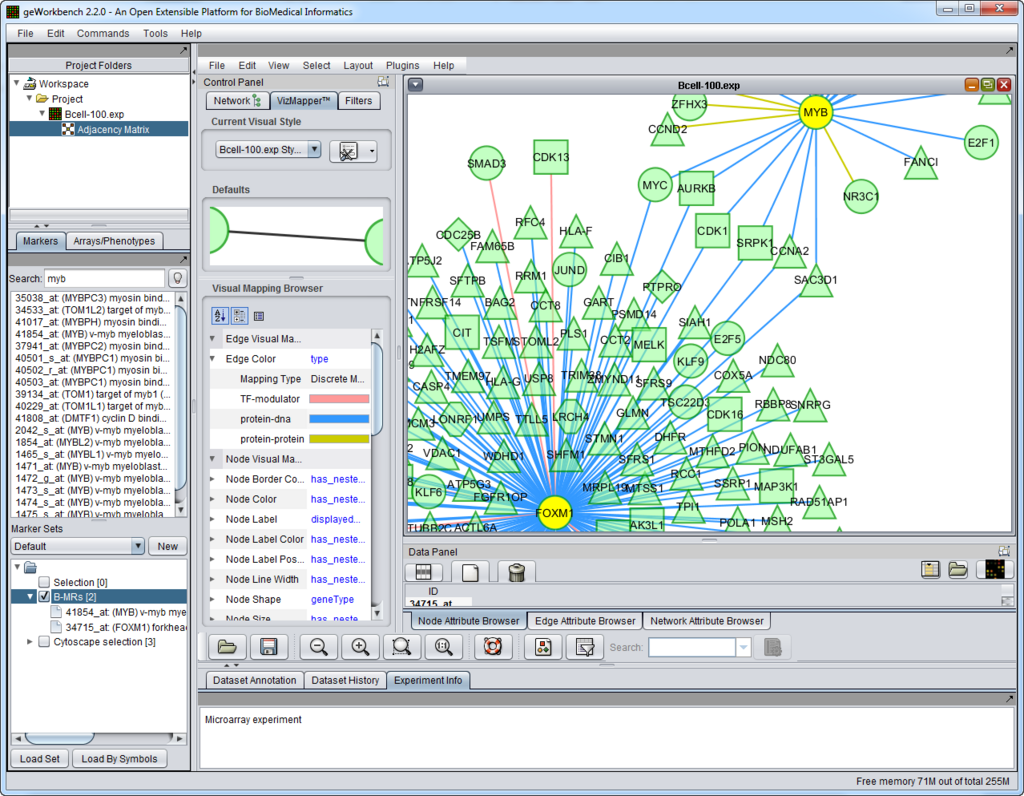Difference between revisions of "Home"
(→Brief Overview of Changes in geWorkbench 2.2.1) |
|||
| Line 1: | Line 1: | ||
| + | ==Note on Tutorial Updates for Release 2.3.0== | ||
| + | The geWorkbench tutorials are currently being updated to match the features of upcoming release 2.3.0. Therefor, not every feature describe there will be found in the current release, 2.2.2. | ||
| + | |||
==Quick Start== | ==Quick Start== | ||
Please see the [[QuickStart| '''Quick Start''']] guide to geWorkbench to see how to get started using geWorkbench right away. We are continuing to develop new material for this guide. | Please see the [[QuickStart| '''Quick Start''']] guide to geWorkbench to see how to get started using geWorkbench right away. We are continuing to develop new material for this guide. | ||
Revision as of 17:32, 21 February 2012
Contents
Note on Tutorial Updates for Release 2.3.0
The geWorkbench tutorials are currently being updated to match the features of upcoming release 2.3.0. Therefor, not every feature describe there will be found in the current release, 2.2.2.
Quick Start
Please see the Quick Start guide to geWorkbench to see how to get started using geWorkbench right away. We are continuing to develop new material for this guide.
Current Release
Welcome to geWorkbench. The current version is 2.2.2, released August 19th, 2011. Release 2.2.2 is a bug fix release, fixing several problems with the Gene Ontology Viewer and Analysis components. It also improves the caArray download graphical interface by sorting arrays by name. The changes are also summarized below.
View the geWorkbench 2.2.2 Release Notes and the change list.
geWorkbench 2.2.2 can be downloaded from the NCI GForge site at https://gforge.nci.nih.gov/frs/?group_id=78. Installation instructions can be found on the Download and Installation page of this Wiki. The Release Notes are also available on GForge.
Overview
geWorkbench (genomics Workbench) is a Java-based open-source platform for integrated genomics. Using a component architecture it allows individually developed plug-ins to be configured into complex bioinformatic applications. At present there are more than 70 available plug-ins supporting the visualization and analysis of gene expression and sequence data. Example use cases include:
- loading data from local or remote data sources.
- visualizing gene expression, molecular interaction networks, protein sequence and protein structure data in a variety of ways.
- providing access to client- and server-side computational analysis tools such as t-test analysis, hierarchical clustering, self organizing maps, regulatory neworks reconstruction, BLAST searches, pattern/motif discovery, etc.
- validating computational hypothesis through the integration of gene and pathway annotation information from curated sources as well as through Gene Ontology enrichment analysis.
geWorkbench is the Bioinformatics platform of MAGNet, the National Center for the Multi-scale Analysis of Genomic and Cellular Networks (one of the 7 National Centers for Biomedial Computing funded through the NIH Roadmap). Additionally, geWorkbench is supported by caBIG®, NCI's cancer Biomedical Informatics Grid initiative.
End-user and developer support for geWorkbench is provided through the caBIG® Molecular Analysis Tools Knowledge Center, a component of the caBIG® Enterprise Support Network.
Graphical User Interface
The figure above shows the full geWorkbench graphical user interface. The Cellular Network Knowledge Base B-cell interactome was queried for interactions of two master regulator genes, and the result displayed in Cytoscape.
Brief Overview of Changes in geWorkbench 2.2.2
Release Date: 8/19/2011
- In the caArray download dialog, arrays are now sorted by name.
- The following problems in using the Gene Ontology components were fixed:
- Marker sets returned from the Tree Browser was not properly appearing in marker selection pulldown menus (e.g. ARACNe hub marker selection).
- After restoring a saved workspace, the reference gene list in the GO analysis component was not populated.
- In some cases, the GO Tree Browser returned markers having no EntrezID along with the expected markers.
View the geWorkbench 2.2.2 Release Notes and the change list.
geWorkbench 2.2.2 can be downloaded from the NCI GForge site at https://gforge.nci.nih.gov/frs/?group_id=78. Installation instructions can be found on the Download and Installation page of this Wiki. The Release Notes are also available on GForge.
Brief Overview of Changes in geWorkbench 2.2.1
Release Date: 7/29/2011
This release augments the recently released version 2.2.0, and includes more than 90 additional enhancements and bug fixes, with many focused on network import, display and export, sequence retrieval, and pattern discovery. It also corrects two omissions from release 2.2.0.
- Alternate file viewer for large networks that may be too large to view in Cytoscape.
- Improvements to display of probeset-level networks.
- Networks can now be imported either from ARACNe adjacency matrix files or from SIF files. Networks can be represented by gene symbols, Entrez IDs, probeset names, or other identifiers.
- Adds support for use of alternate ontology files (e.g. from the GO website) for gene ontology analysis.
- Sequence retrieval for DNA sequences is now based on refSeq records from the UCSC refGene table, and is available for all organisms with genomes supported by UCSC.
- The new "Fold Change" analysis component, omitted from release 2.2.0, is included.
- A feature to overlay a t-test result onto a Cytoscape network, not functional as released in version 2.2.0, now works correctly.
- Bonferroni correction added to the ARACNe GUI.
For a full list of changes, see Changes.
Previous Releases
See the Previous Releases page for full details.

